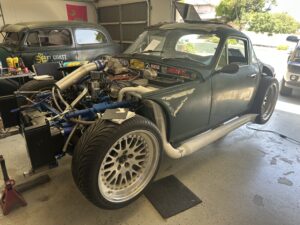
This 1975 TVR Vin Verification was done by our team member in Moreno Valley, Ca. on 8-5-2025

This 1975 TVR Vin Verification was done by our team member in Moreno Valley, Ca. on 8-5-2025
The 1975 TVR represents a unique chapter in the story of the small British automaker TVR, known for its handcrafted sports cars that emphasized raw performance and distinctive styling. In 1975, TVR was producing models such as the 2500M, 3000M, and the rare TVR 1600M, all of which carried the company’s hallmark design language: lightweight construction, compact dimensions, and strong performance. Unlike mass-produced sports cars from larger manufacturers, TVRs were built in limited numbers, giving them an exclusive appeal.
TVR, founded in Blackpool, England in 1947 by Trevor Wilkinson, had carved out a reputation by the 1970s for creating small, fast, and engaging driver’s cars. By 1975, the company was in its M-Series era (produced between 1972–1979). These cars replaced the earlier TVR Vixen and Tuscan models and helped stabilize the company during a time when it was seeking financial security. The 1975 lineup mainly consisted of the 1600M (Ford Kent engine), 2500M (Triumph 2.5L inline-six), and 3000M (Ford Essex V6).
The 1975 TVR models offered a variety of engines depending on customer preference and market:
TVR 1600M: Powered by a 1.6L Ford Kent inline-four, producing around 86 horsepower. While modest in output, its lightweight chassis made it lively and engaging to drive.
TVR 2500M: Equipped with a 2.5L Triumph inline-six, producing about 106 horsepower. This was the most common engine choice, particularly for export markets like the U.S.
TVR 3000M: The most powerful variant, fitted with a 3.0L Ford Essex V6 making roughly 138 horsepower. This model was capable of 0–60 mph in under 8 seconds, impressive for its era.
All models came with a 4-speed manual gearbox (some later upgraded to 5-speed), and performance was enhanced by the cars’ light weight and excellent handling.
The M-Series TVRs, including the 1975 models, featured fiberglass bodies mounted on tubular steel chassis. Their styling was distinct, with long hoods, a short rear deck, and a low, aggressive stance. The cabin was compact but sporty, offering bucket seats, a wood-trimmed dashboard, and driver-focused gauges. While the build quality was sometimes inconsistent, the design made the TVR stand out compared to more conventional sports cars. The cars had a minimalist philosophy—no unnecessary frills, just a pure connection between driver and machine.
In 1975, TVR’s lineup was made up of different “M” series variants:
TVR 1600M – Entry-level, using Ford’s 1.6L engine.
TVR 2500M – Mid-tier model, popular in the United States with Triumph’s 2.5L six.
TVR 3000M – High-performance version with Ford’s 3.0L V6.
Special Variants: Some limited-production models, like the Turbocharged 3000M, were built later, but in very small numbers.
Like many British sports cars of the era, safety and technology were not strong points. The TVR of 1975 did not feature airbags, ABS, or traction control. Instead, its safety relied on a sturdy tubular frame and responsive handling. Disc brakes at the front and drum brakes at the rear were standard. While simple, the technology was focused on driving engagement rather than convenience or safety.
Fuel economy varied depending on the engine choice:
1600M: Around 25 mpg (best efficiency).
2500M: Approximately 18–22 mpg.
3000M: Around 15–18 mpg, reflecting its performance orientation.
Although not built with efficiency in mind, the lightweight design helped keep fuel consumption reasonable compared to larger sports cars.
In 1975, the TVR competed against sports cars such as the Triumph TR6, MG B GT, Porsche 914, and Datsun 240Z/260Z. Compared to these rivals, the TVR offered rarity, stronger performance-to-weight ratio, and exclusivity. However, it lacked the refinement, dealer support, and long-term reliability of some competitors. Enthusiasts often considered the TVR a driver’s car for purists, rather than a mainstream sports coupe.
Original MSRP (1975): Prices varied depending on the model but typically ranged from $4,500 to $6,500 USD.
Current Value (Collector Market): Today, depending on condition, rarity, and model, a 1975 TVR can range from $15,000 for a 1600M to $35,000–$50,000 for a well-preserved 3000M. Restored examples or rare turbocharged versions can bring even higher prices.
TVRs from the 1970s developed a cult following among enthusiasts who valued their raw, lightweight driving experience.
The 3000M was often praised by period automotive journalists for its speed and handling, earning a reputation as a “giant killer” against more expensive sports cars.
Today, the 1975 TVR models are celebrated as rare collectibles that embody the spirit of handcrafted British performance cars.
Need a VIN Verification? We are licensed to complete the REG 31 form. Call to get your car, truck or motorcycle verified today!
© 2025 QUICK VIN VERIFICATION. All rights reserved.